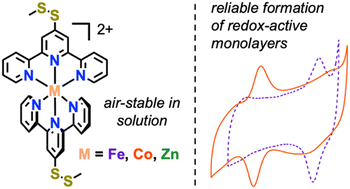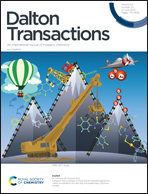Methyldisulfide groups enable the direct connection of air-stable metal bis(terpyridine) complexes to gold surfaces†
Abstract
We show that a new terpyridine ligand comprising a directly-connected methyldisulfide group (tpySSMe) can be used to prepare a modular series of metal bis(terpyidine) complexes, [M(tpySSMe)2](PF6)2 (M = Fe, Co, Zn), suitable for the functionalization of metal surfaces. Critically, we find these complexes are air-stable in solution for >7 d, in stark contrast to their thiol-substituted analogues, [M(tpySH)2](PF6)2 (M = Fe, Co), which decompose in <1 d. While CoSH has previously been utilized in several important studies, we explicitly detail its synthesis and characterization here for the first time. We subsequently probe the electrochemical properties of [M(tpySSMe)2](PF6)2 in solution, showing that the (electro)chemical reactions associated with disulfide reduction significantly increase the complexity of the voltammetric response. In preliminary surface voltammetry studies, we confirm that CoSS and FeSS form solution-stable self-assembled monolayers (SAMs) on gold with comparable electrochemical properties to those formed from CoSH. Taken together, this work provides a robust foundation for future studies of this prominent class of complexes as redox-active components of SAMs or single-molecule junctions.

- This article is part of the themed collection: Spotlight Collection: Inorganic Molecular Electronics


 Please wait while we load your content...
Please wait while we load your content...